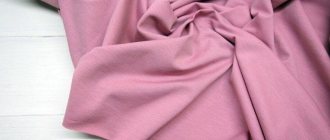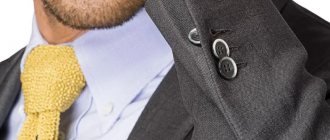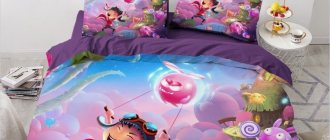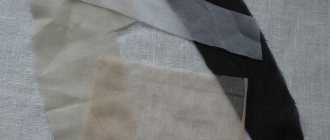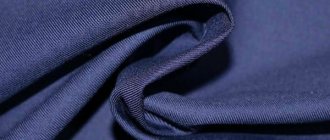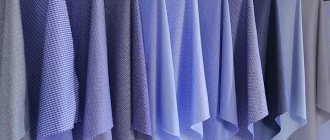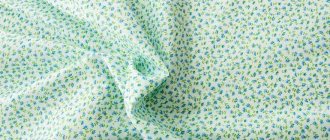What is a cooler
Translated from French, “kulirka” means “bend.” Knit fabric is a type of single-layer cross-knitted fabric. The main element of the structure is a loop consisting of a connecting broach and a frame. On the front side, the cooler fabric looks like vertical braids. The back loop design is reminiscent of brickwork. Cooler fabric is the smoothest and thinnest knitwear, which can be made from 100% cotton or with the addition of 5-10% lycra to increase the shape and wear resistance of the fiber.
The canvas is available in different densities. The thinnest surface is created from 100% cotton with a small addition of elastane. This fabric is used to make linen. High-density kulirka material is used for sewing knitted outerwear. Due to the high content of chemical fibers in dense fabric, products do not stretch, shrink, or wrinkle.
Knitted cooler fabric: description and properties of the material
Kulirka – cross-knitted 100% cotton jersey. Very smooth and thin. The main structural element is a straight loop. The front side of the fabric is smooth and consists of a number of vertically arranged thin braids. The reverse pattern resembles brickwork.
Easily blooms in any direction. Excellent stretch and retains its shape for a long time.
If the base is 100% cotton, the fabric is characterized by: softness, excellent hygienic qualities, antistatic, breathable, light.
When synthetics are added, the following properties will be added: increased elasticity, wear resistance, elasticity and stretchability.
Description
When buying knitwear, the question often arises: what kind of fabric is it? Everyone is familiar with the traditional names (calico, cotton, flax). However, when many buyers see the name of the cooler on the label, they are perplexed. Fabric made by machine using stockinette knitting cotton threads produces excellent quality children's, women's and men's clothing. Kulirka knitwear is thin and smooth, so shirts, shorts, T-shirts, and robes made from it are highly valued by connoisseurs.
Description of kulirka-kabartma fabric
Kulirka-kabartma is a smooth, usually cotton knitted fabric. Upon closer inspection of the fabric, you will notice a vertical weaving pattern in the form of braids on the front side and transverse loops on the back. The knitwear is thin, light, and breathable.
Reference! The smooth surface of kulirka-kabartma knitwear is ensured by production technology: transverse weaving of one or several threads to form loops, alternating sequentially one after another.
Compound
As already mentioned, the cooler mainly contains pure cotton fibers, but sometimes additional materials are added to it for elasticity:
- Polyurethane. Increases durability and elasticity. Polyurethane has hypoallergenic characteristics and ensures the preservation of the color of the fabric. Even after many washes, a product with this composition will remain bright. The disadvantage of this connection is the fact that after the first wetness the clothes shrink slightly.
- Polyester. Often added together with polyurethane. Thanks to this, clothes do not fade or shrink after washing. Polyester provides cotton fiber with high density. The disadvantage is that the material is hard and hygroscopic.
- Lycra. The additive is used to make clothes stretch better across the width. A cooler with lycra is also called singing.
- Wool, silk. Materials are also sometimes added to the stockinette. Such a connection is rarely made.
Properties
Since the drawstring fabric is double-sided, durability is its main quality. The characteristics of the fabric include good breathability, which allows the body to ventilate and breathe. This property is suitable for making clothes from cotton wool for any season. Waist stitch is especially suitable for babies - in diapers made from such weaving, a child will never develop diaper rash. Knitwear can be colored or plain. Thanks to the unique structure of the weave fabric, the designs on it last for a very long time. Main properties of the canvas:
- strength;
- hygroscopicity;
- wear resistance;
- hygiene.
Does it stretch or not?
Judging by customer reviews, the cuff fabric stretches greatly in width, but hardly stretches in length. This characteristic provides an excellent opportunity to not restrict movement when wearing underwear, a T-shirt or other clothing that fits close to the body. This property also prevents the products from stretching after washing and retaining their shape for a long time, which indicates a long service life.
Production
The manufacturing process of the cooler fabric is controlled at all stages of production. The fabric is made from interwoven knitted threads (cotton plus additional materials). The cooler is made from three types of yarn, depending on the scope of application:
- Peña. Consists of long fibers (80 cm). The most expensive and high-quality raw materials, since the length helps the material keep its shape well.
- Card. The yarn length is medium (27-35 cm). This fabric is less elastic and durable.
- Open end. The shortest yarn (less than 27 cm). It includes residues from previous types of fibers. Used in the field of sewing products that do not require an ideal shape.
Properties and types
A cooler with lycra has the same hygienic and physical properties as a classic one made of pure cotton:
- hygroscopicity. Capable of absorbing an amount of moisture equal to 15-20% of its own weight;
- breathability. In products made from this material, the body “breathes”;
- hypoallergenic. The material is made from environmentally friendly raw materials and does not cause allergies.
Physical properties:
- softness. Very pleasant to the touch and does not cause skin irritation;
- strength and durability. Products made from it do not tear and last a long time;
- firmness and elasticity. It stretches well and returns to its original shape, practically does not wrinkle.
Thanks to the addition of elastane fibers, the mechanical strength and elasticity of the fabric increases; items made from it are shape-resistant: they stretch and completely restore their shape without stretching, and do not shrink after washing.
The disadvantages of the material include a strongly curled edge, which usually causes inconvenience when cutting and sewing; the edges of thin knitwear need to be processed in a special way.
Sometimes a certain percentage of polyester is added to cotton and elastane fibers, which reduces the hygroscopicity and softness of the fabric, adding strength and wear resistance to it. This material is cheaper than natural material. When choosing products, it is recommended to take into account the composition and choose those in which the polyester content does not exceed 20%.
The canvas fabric lends itself well to dyeing, prints perfectly on it, and can be plain-dyed or printed.
Depending on the length and quality of the threads used, there are several types:
- singing - made from threads 35-70 mm long and is the most expensive and high-quality. This material does not form pills, it does not shrink, and printed designs fit perfectly on it;
- cardier or ring - has a coarser texture than pene, made of threads of shorter length (up to 35 mm);
- Open end knitwear is made from the shortest threads and is considered the lowest in quality. Pellets may form on the surface.
Varieties
Cotton fabrics have proven themselves to be a material that can be easily dyed. The stockinette stitch is no exception, and the unique weaving helps create a special decorative effect. Dyeing of the canvas occurs using the traditional method, no different from other methods of adding color to fabrics. There are three types of lining fabric:
- Melange knitted surface. In its production, cotton threads of different colors are used, which are always combined with each other.
- Smoothly dyed fabric. The material is painted evenly, but can be of different colors.
- Knitted stitch with a printed pattern. The fabric is characterized by high surface density. The printed pattern is applied using different technologies.
Advantages and disadvantages
For those with sensitive skin and those who appreciate comfort, the cooler is the ideal fabric. The material has many advantages - it absorbs moisture and allows air to pass through, it is practical and hypoallergenic, strong and durable. Clothes made from stockinette do not require special care, are light, airy and are sold at an affordable price. The variety of colors, styles and the ability to be used in many areas of life are also a big plus for this fabric material. Waist linen has only one drawback: after incorrect washing, the item may shrink in size.
Pros and cons of fabric
Cooler advantages:
- Versatility. It is suitable for sewing both adult and newborn clothes.
- Minimal creasing. The material practically does not wrinkle, it is convenient to iron, although this is not necessary.
- Hygroscopicity. The fabric easily absorbs any moisture, so temperature exchange takes place without obstacles.
- Environmentally friendly. The material is knitted from pure natural fibers, and therefore is easy to use and does not harm the environment.
- Durability. Does not fade and does not lose shape or color.
- Low price.
Flaws:
- Fabric care. There are many types of coolers, so each of them requires special care and washing parameters: temperature, rinsing and everything else is adjusted according to the composition of the fabric.
- At high (45 degrees water or more) temperatures, the fabric undergoes severe shrinkage and loses its shape.
- Jumper yarns made from short cotton yarns will begin to pill within a short period of time.
Comparison with analogues
There are many types of knitted fabric, but each one is different. The characteristics of each canvas are such that they are not interchangeable. Brief characteristics of fabrics similar to kulirka:
- Footer. A warm, dense fabric that is smooth on the front side and softly brushed on the back. Knitwear stretches slightly, shrinks noticeably when soaked, and does not form pills. Products made from lining can only be washed at low temperatures up to 30°C. The canvas is recommended for creating warm clothes.
- Ribana. Double-sided knitwear, which is obtained by double cross-knit weaving. The surface of the ribana is structured on both sides in the form of small stripes. The material holds its shape well and only stretches in width. Ribana is usually used to create children's collections.
- Pique. Lightweight mixed-weave knitwear with anti-shrink properties. Products can be safely washed in hot water. Pique is great for creating summer clothes.
- Diuretic herbs and preparations - list. What diuretic herbs to drink for high blood pressure, edema and weight loss
- How to reduce jpg file size
- How to find a phone using GPS via a computer and the Internet. Phone tracking via satellite
Kulirka and interlock - what's the difference?
Interlock is a widely used knitwear. The fabric is obtained by weaving “elastic”, when the back and front columns alternate. Interlock is a double-sided material, which provides it with low elongation in length/width and high density. If the thread accidentally breaks, this knitted fabric almost does not unravel. The fabric is used to make children's clothing, but due to the density of the weave, it is not suitable for a summer collection. Interlock is superior to cooler in strength and wear resistance, but the latter is lightweight and thin.
How does cooler differ from footer and interlock?
For kids and adults, everyday clothes are sewn from footer. This is a strong, comfortable, dense, pleasant, cotton thing. Cotton is used to make such a very soft textile with a smooth outer surface. There is also a small fleece inside. Well resistant to the appearance of pellets or arrows.
Double elastic is the name given to thin interlock. Today, manufacturers often add synthetic yarns to the material. Although ideally, only natural fibers should be used. In case of mechanical damage, unlike the cooler, puffs do not appear. In the photo you can see the difference in fabrics.
Children `s dress
Interlock will always be double-sided. Natural yarns are inserted into this material using a special method. Even if the material is of poor quality, it will not lose its shape after long-term use.
You might be interested in this Detailed description and features of drape fabric
What do they sew from a cooler?
We figured it out a little, kulirka - what kind of fabric is it, but what is it used to sew? Satin stitch is a universal material. It is widely used for sewing both adult and children's clothing. Thanks to its hypoallergenicity and durability, the weave fabric produces very high-quality underwear, which is appreciated by people with sensitive skin. Clothes made from this knitwear for home use (pajamas, dressing gowns) are of high quality, comfortable to wear and affordable.
Summer clothes made from knitted satin stitch perfectly allow air to pass through, look great in both a tight-fitting and loose fit, and are light in texture. On hot summer days, skirts, trousers, tunics, leggings and other items made from this knitted fabric are ideal. Since the fabric absorbs liquid well, it is excellent for sewing high-quality sportswear. Most of the items produced from knitwear are for the youngest consumers:
- hats;
- slips;
- sliders;
- bodysuit;
- baby vests;
- diapers, etc.
Scope of application
After it has become clear what it is - kulirka fabric, you need to figure out what kind of clothes are made from it. The versatility of the material allows you to sew from it:
- Underwear for adults. It is known that elevated temperature leads to poor health. In some cases it can lead to infertility. Therefore, the underwear should allow air and moisture to pass through.
- T-shirts and tank tops. Produced for both children and adults. In summer, active sweating can lead to sweating, severe skin irritation and even allergies. It is necessary for the moisture to escape and in this case the cooler is better suited than other fabrics.
- Dresses. Regular casual dresses are often made from cotton fabrics. They allow you to maintain air and temperature exchange even on a very hot hike.
- Robes. Bathrobes and dressing gowns made from kulirka are very popular, because the fabric is soft, does not stick to the body and creates the comfort that you should have after a hard day. In addition, they do not lose color for a long time, even with constant wear.
- Nighties. Many note that they are more comfortable than silk models. The reason for this is softness and lightness. Plus, they are much cheaper.
- Hats. Summer baseball caps help your head not to sweat and allow you to play sports longer, including outdoor games.
- Sportswear. Active sports (running, cycling, cardio exercises in the gym) should be carried out in light, breathable underwear.
You can see photos of clothes from the cooler below.
Basic rules of care
In order for items made from cotton fabric to last a long time, you need to know the rules for caring for them. Before first use, a new product must be washed. For this purpose, it is advisable to purchase a detergent for delicate washing: powder with a gentle composition or gel. Bleach, stain removers and other aggressive household chemicals can harm the material. Wash by hand or use delicate cycle in a washing machine. Before carrying out it, you need to take note of the following rules:
- the water temperature should not be higher than 30 degrees;
- It is better to spin manually using a towel (at least at the lowest speed);
- If there are stubborn stains, they must be removed with laundry soap or using a delicate stain remover.
It is better to dry things not vertically with clothespins, but horizontally on a towel. This is necessary to maintain the shape of the clothing. It is important to avoid exposure to sunlight so that the color of the product remains unchanged longer. Since knitwear does not wrinkle, it is not necessary to iron it. If ironing is required (for example, baby diapers), then the correct temperature is 110 degrees. As you can see, the cooler is an unpretentious material. With proper care, items made from this fabric will delight their owners for many years.
Cooler fabric: what is it, composition, density
Made from three types of yarn:
- Penye - threads whose length reaches 85 mm. This material is of quite high quality and has a high cost, since the longer the fibers, the longer the item will last.
- Carde - average thread length - 30 mm. A thing made of such material will not last very long.
- O/E—short thread—its length is approximately 25 mm. It will contain residues from other threads. It is used in those products where holding the shape is not particularly necessary.
Linen is a product that mainly consists of cotton. But if desired, you can add lycra for elasticity. The quality remains the same, but the scope of application is expanding.
On a note! It is recommended that the amount of Lycra added does not exceed 15%. Because this fabric is the thinnest of all types of cotton knitwear.
Kulirka, like fabric, is produced in such a way that a series of loops are obtained by knitting one yarn. Has a small thickness. That's why the material comes out so thin. The cross knitting technique is used. Manufacturers make material - single and double, which is used for various types of sewing.
Painted canvas
It can be either colored or plain. Due to the composition of the material, the drawings on it last quite a long time. Depending on the type of pattern, there are three types of fabric: printed, melange and plain-dyed. The material is also suitable for embroidery or silk-screen printing.
Varieties of cool fabric
The properties of the finished knitwear directly depend on the density of the weave and the original raw materials.
On a note! The appearance of the material primarily determines the type of yarn used for knitting. Generally thick or thin, elastic or resilient, glossy or matte. It all depends on the length of the thread of the source material.
It is obtained from several types of yarn:
- Foam material. Long length threads are used for it, which gives the right to obtain one of the most expensive and high-quality materials. The threads also go through a grinding stage (excess lint is removed from the surface), after which they turn out smooth and even. Washing the fabric is easy, almost does not wrinkle, no pills appear on it, and does not shrink after washing. Smooth and silky texture to the touch. It also interacts well with dyes. Such products will last a long time and have a new look.
- Card. Cool card, what kind of fabric, characteristics. Made from medium threads. Textiles made from it are mostly stretchable and have a short service life. Therefore, clothes made from such material are very affordable. Carde is used for household items.
- Open End. To make fabric from this type of thread, short threads or remnants of the first two more acceptable types of yarn are used. Material made from this raw material is used for inexpensive underwear. Since it wrinkles a lot, such underwear will not last very long and you don’t mind throwing it away.
You may be interested in What is jersey knitwear: description of fabric and composition
It depends on the type of yarn.
- plain painted;
- melange;
- Printed.
On a note! Due to the different weaving of the threads, designs can be applied to the fabric in various ways, embroidery, silk-screen printing or prints can be used. The appearance of the fabric can be seen in the photo below.
Children's things from the cooler
Fabric price
The cost of the cooler is low. Finding and buying it today is not difficult. If this knitwear is not on sale in your city, then it is easy to order the material from a photo in the catalog and buy it in an online store. Fabric is often sold online at a discounted price, so such a purchase will be more profitable even taking into account delivery. Average cost of a cooler in stores in the Moscow region:
| Name | Price, ruble/meter |
| Cooler stretch | 680, 00 |
| Plain cooler | 370,00 |
| Kulirny stitch with lycra | 430, 00 |
